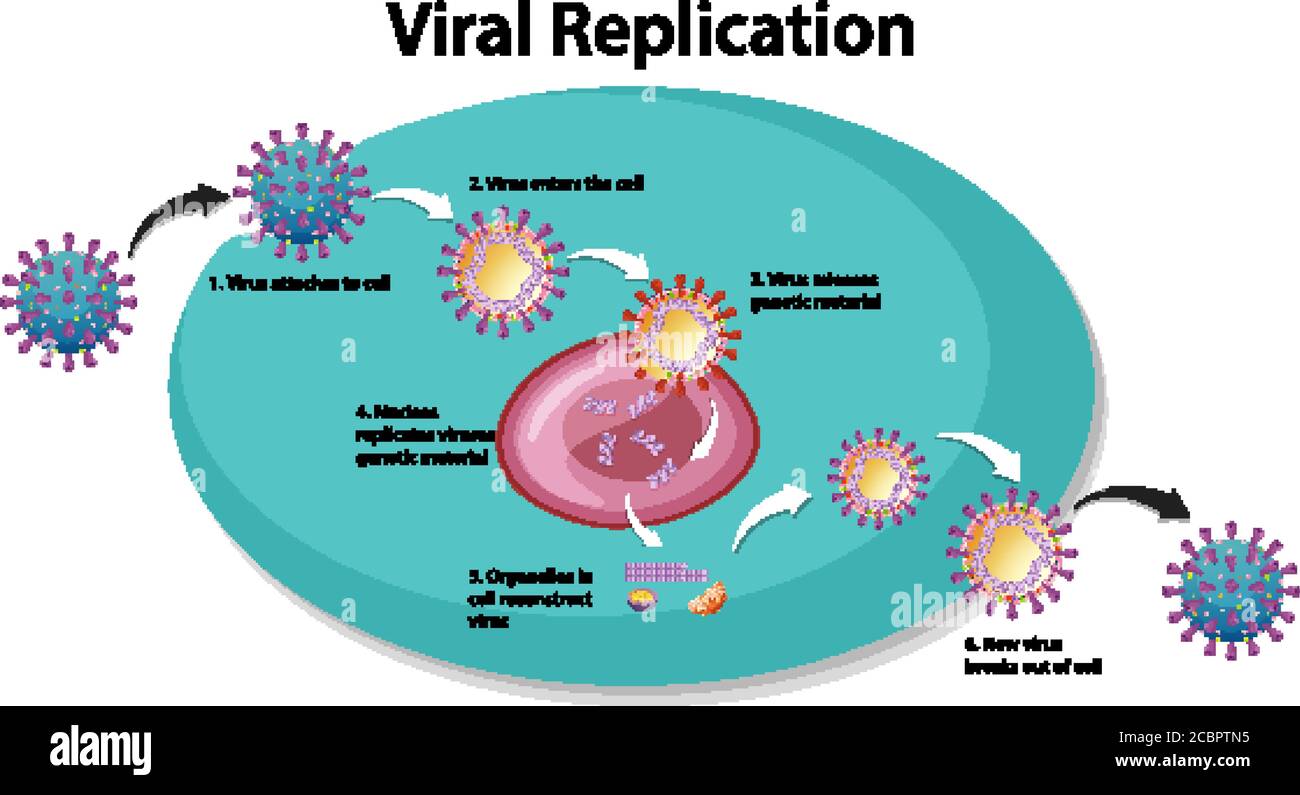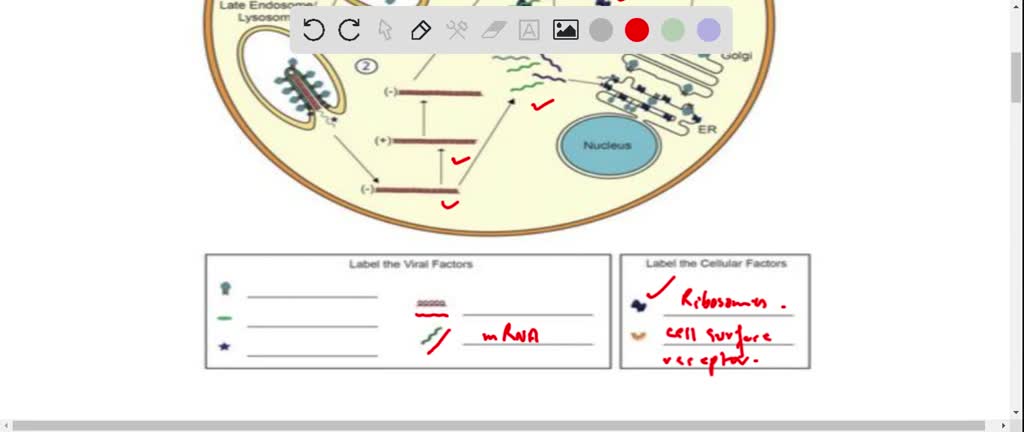This occurs through contraction of the tail sheath, which acts like a hypodermic needle to inject the viral genome through the cell wall and membrane. The phage head and remaining components remain outside the bacteria. Figure 3.1.2.2 3.1.2. 2: A virulent phage shows only the lytic cycle pictured here.
Pathogens | Free Full-Text | An Overview of the Pathogenesis, Transmission, Diagnosis, and Management of Endemic Human Coronaviruses: A Reflection on the Past and Present Episodes and Possible Future Outbreaks
Science Biology Biology questions and answers Label this generalized diagram of viral replication. Host cell Viral nucleic acid YYYYYYT Release of virus from the host cell Replication of viral genome Production of viral proteins Assembly of new viruses Cell surface receptor Virus This problem has been solved!

Source Image: alamy.com
Download Image
A generalized representation of the replication of two viruses. Replication of a DNA virus is shown in (1); replication of an RNA virus is displayed in (2). For the release of new viral particles, any of a number of processes may occur. For example, the host cell may be “biochemically exhausted,” and it may disintegrate, thereby releasing

Source Image: numerade.com
Download Image
Viruses | Free Full-Text | Imaging Techniques to Study Plant Virus Replication and Vertical Transmission Viral Replication Scott M. Hammer, M.D. Viral Replication: Basic Concepts • Viruses are obligate intracellular parasites • Viruses carry their genome (RNA or DNA) and sometimes functional proteins required for early steps in replication cycle • Viruses depend on host cell machinery to complete replication cycle and must commandeer

Source Image: mdpi.com
Download Image
Label This Generalized Diagram Of Viral Replication
Viral Replication Scott M. Hammer, M.D. Viral Replication: Basic Concepts • Viruses are obligate intracellular parasites • Viruses carry their genome (RNA or DNA) and sometimes functional proteins required for early steps in replication cycle • Viruses depend on host cell machinery to complete replication cycle and must commandeer Sep 13, 2023Figure: Hepatitis C virus: A simplified diagram of the Hepatitis C virus replication cycle. Following the structure-mediated self-assembly of the virus particles, some modification of the proteins often occurs. In viruses such as HIV, this modification (sometimes called maturation) occurs after the virus has been released from the host cell.
Vaccines | Free Full-Text | Oncolytic Viruses: An Inventory of Shedding Data from Clinical Trials and Elements for the Environmental Risk Assessment
Transduction occurs when a bacteriophage transfers bacterial DNA from one bacterium to another during sequential infections. There are two types of transduction: generalized and specialized transduction. During the lytic cycle of viral replication, the virus hijacks the host cell, degrades the host chromosome, and makes more viral genomes. Schematic overview of the steps in a standard viral replication cycle… | Download Scientific Diagram

Source Image: researchgate.net
Download Image
Molecules | Free Full-Text | A Spotlight on Viruses—Application of Click Chemistry to Visualize Virus-Cell Interactions Transduction occurs when a bacteriophage transfers bacterial DNA from one bacterium to another during sequential infections. There are two types of transduction: generalized and specialized transduction. During the lytic cycle of viral replication, the virus hijacks the host cell, degrades the host chromosome, and makes more viral genomes.

Source Image: mdpi.com
Download Image
Pathogens | Free Full-Text | An Overview of the Pathogenesis, Transmission, Diagnosis, and Management of Endemic Human Coronaviruses: A Reflection on the Past and Present Episodes and Possible Future Outbreaks This occurs through contraction of the tail sheath, which acts like a hypodermic needle to inject the viral genome through the cell wall and membrane. The phage head and remaining components remain outside the bacteria. Figure 3.1.2.2 3.1.2. 2: A virulent phage shows only the lytic cycle pictured here.

Source Image: mdpi.com
Download Image
Viruses | Free Full-Text | Imaging Techniques to Study Plant Virus Replication and Vertical Transmission A generalized representation of the replication of two viruses. Replication of a DNA virus is shown in (1); replication of an RNA virus is displayed in (2). For the release of new viral particles, any of a number of processes may occur. For example, the host cell may be “biochemically exhausted,” and it may disintegrate, thereby releasing

Source Image: mdpi.com
Download Image
HBsAg, Subviral Particles, and Their Clearance in Establishing a Functional Cure of Chronic Hepatitis B Virus Infection | ACS Infectious Diseases Jul 17, 2023A virus is a small infectious agent that replicates inside the cells of other organisms. Examples of common diseases caused by viruses include the common cold, influenza and chickenpox (varicella zoster virus). Once an infection has begun it provokes an immune response from the host that typically eliminates the invading virus – this same immune response can also be generated using “dead” or

Source Image: pubs.acs.org
Download Image
Potent Inhibitory Activities of the Adenosine Analogue Cordycepin on SARS-CoV-2 Replication | ACS Omega Viral Replication Scott M. Hammer, M.D. Viral Replication: Basic Concepts • Viruses are obligate intracellular parasites • Viruses carry their genome (RNA or DNA) and sometimes functional proteins required for early steps in replication cycle • Viruses depend on host cell machinery to complete replication cycle and must commandeer

Source Image: pubs.acs.org
Download Image
Structure, Function, and Antigenicity of the SARS-CoV-2 Spike Glycoprotein – ScienceDirect Sep 13, 2023Figure: Hepatitis C virus: A simplified diagram of the Hepatitis C virus replication cycle. Following the structure-mediated self-assembly of the virus particles, some modification of the proteins often occurs. In viruses such as HIV, this modification (sometimes called maturation) occurs after the virus has been released from the host cell.

Source Image: sciencedirect.com
Download Image
Molecules | Free Full-Text | A Spotlight on Viruses—Application of Click Chemistry to Visualize Virus-Cell Interactions
Structure, Function, and Antigenicity of the SARS-CoV-2 Spike Glycoprotein – ScienceDirect Science Biology Biology questions and answers Label this generalized diagram of viral replication. Host cell Viral nucleic acid YYYYYYT Release of virus from the host cell Replication of viral genome Production of viral proteins Assembly of new viruses Cell surface receptor Virus This problem has been solved!
Viruses | Free Full-Text | Imaging Techniques to Study Plant Virus Replication and Vertical Transmission Potent Inhibitory Activities of the Adenosine Analogue Cordycepin on SARS-CoV-2 Replication | ACS Omega Jul 17, 2023A virus is a small infectious agent that replicates inside the cells of other organisms. Examples of common diseases caused by viruses include the common cold, influenza and chickenpox (varicella zoster virus). Once an infection has begun it provokes an immune response from the host that typically eliminates the invading virus – this same immune response can also be generated using “dead” or